Implementing Disruptive Technologies for Operational Disruption Management in Qantas Airways
VerifiedAdded on 2022/12/22
|8
|1980
|38
AI Summary
This report explains how Qantas Airways can implement disruptive technologies to manage operational disruption and gain a competitive advantage. It discusses the impact of emerging technologies on the aviation industry and the challenges faced by airlines in managing disruptions. The report also highlights the initiatives taken by Qantas Airways to improve disruption management and enhance customer experience.
Contribute Materials
Your contribution can guide someone’s learning journey. Share your
documents today.
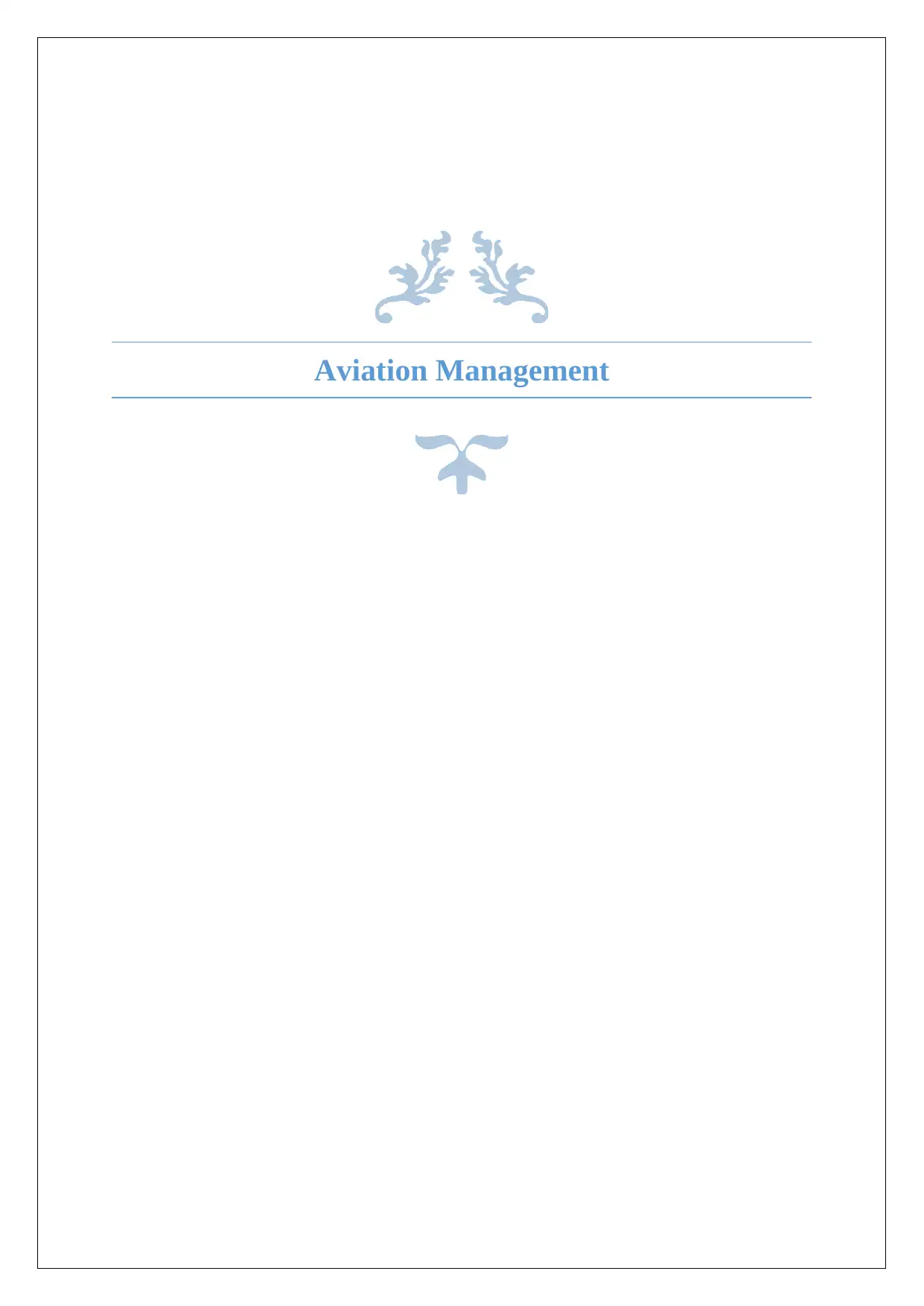
Aviation Management
Secure Best Marks with AI Grader
Need help grading? Try our AI Grader for instant feedback on your assignments.
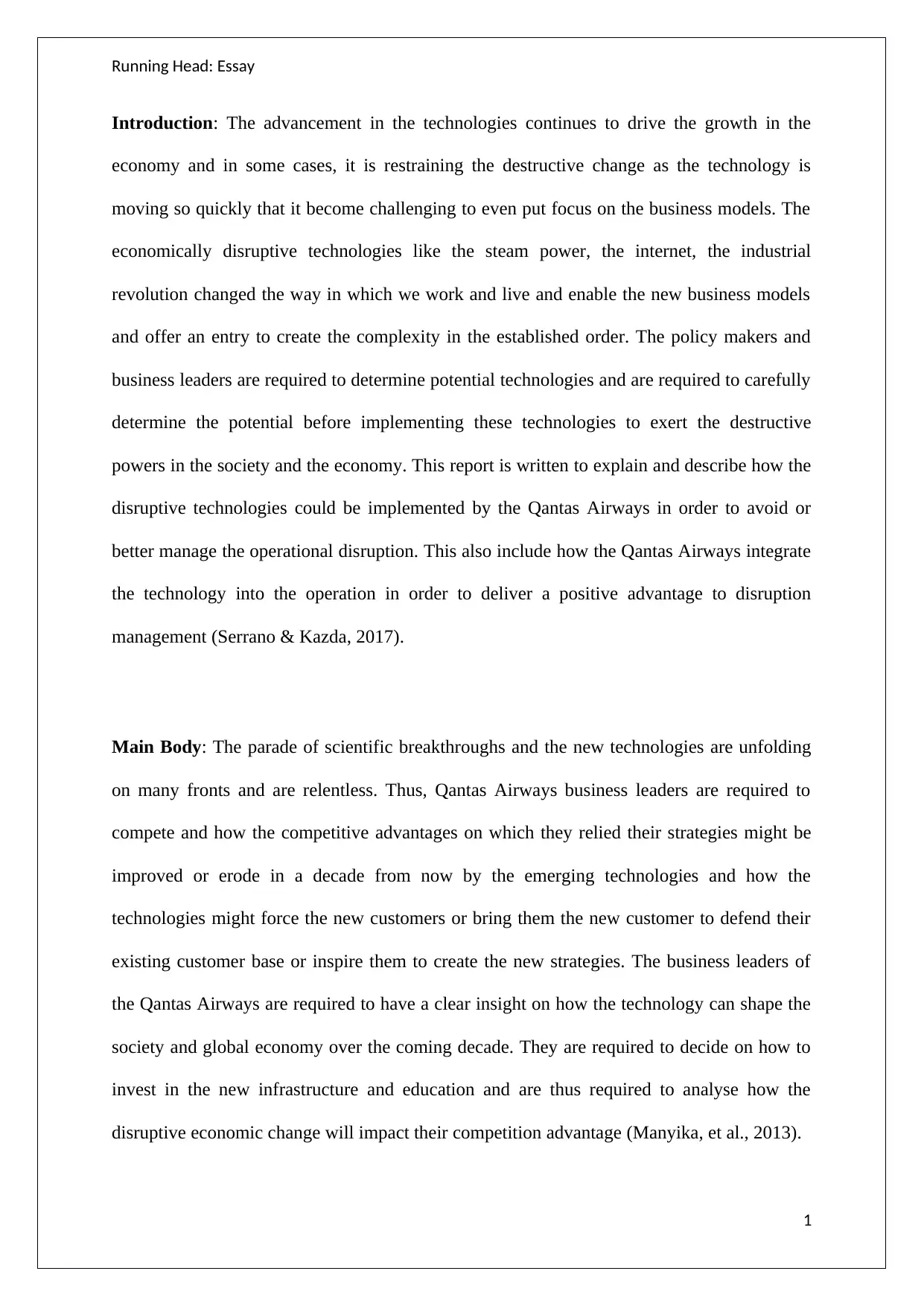
Running Head: Essay
Introduction: The advancement in the technologies continues to drive the growth in the
economy and in some cases, it is restraining the destructive change as the technology is
moving so quickly that it become challenging to even put focus on the business models. The
economically disruptive technologies like the steam power, the internet, the industrial
revolution changed the way in which we work and live and enable the new business models
and offer an entry to create the complexity in the established order. The policy makers and
business leaders are required to determine potential technologies and are required to carefully
determine the potential before implementing these technologies to exert the destructive
powers in the society and the economy. This report is written to explain and describe how the
disruptive technologies could be implemented by the Qantas Airways in order to avoid or
better manage the operational disruption. This also include how the Qantas Airways integrate
the technology into the operation in order to deliver a positive advantage to disruption
management (Serrano & Kazda, 2017).
Main Body: The parade of scientific breakthroughs and the new technologies are unfolding
on many fronts and are relentless. Thus, Qantas Airways business leaders are required to
compete and how the competitive advantages on which they relied their strategies might be
improved or erode in a decade from now by the emerging technologies and how the
technologies might force the new customers or bring them the new customer to defend their
existing customer base or inspire them to create the new strategies. The business leaders of
the Qantas Airways are required to have a clear insight on how the technology can shape the
society and global economy over the coming decade. They are required to decide on how to
invest in the new infrastructure and education and are thus required to analyse how the
disruptive economic change will impact their competition advantage (Manyika, et al., 2013).
1
Introduction: The advancement in the technologies continues to drive the growth in the
economy and in some cases, it is restraining the destructive change as the technology is
moving so quickly that it become challenging to even put focus on the business models. The
economically disruptive technologies like the steam power, the internet, the industrial
revolution changed the way in which we work and live and enable the new business models
and offer an entry to create the complexity in the established order. The policy makers and
business leaders are required to determine potential technologies and are required to carefully
determine the potential before implementing these technologies to exert the destructive
powers in the society and the economy. This report is written to explain and describe how the
disruptive technologies could be implemented by the Qantas Airways in order to avoid or
better manage the operational disruption. This also include how the Qantas Airways integrate
the technology into the operation in order to deliver a positive advantage to disruption
management (Serrano & Kazda, 2017).
Main Body: The parade of scientific breakthroughs and the new technologies are unfolding
on many fronts and are relentless. Thus, Qantas Airways business leaders are required to
compete and how the competitive advantages on which they relied their strategies might be
improved or erode in a decade from now by the emerging technologies and how the
technologies might force the new customers or bring them the new customer to defend their
existing customer base or inspire them to create the new strategies. The business leaders of
the Qantas Airways are required to have a clear insight on how the technology can shape the
society and global economy over the coming decade. They are required to decide on how to
invest in the new infrastructure and education and are thus required to analyse how the
disruptive economic change will impact their competition advantage (Manyika, et al., 2013).
1
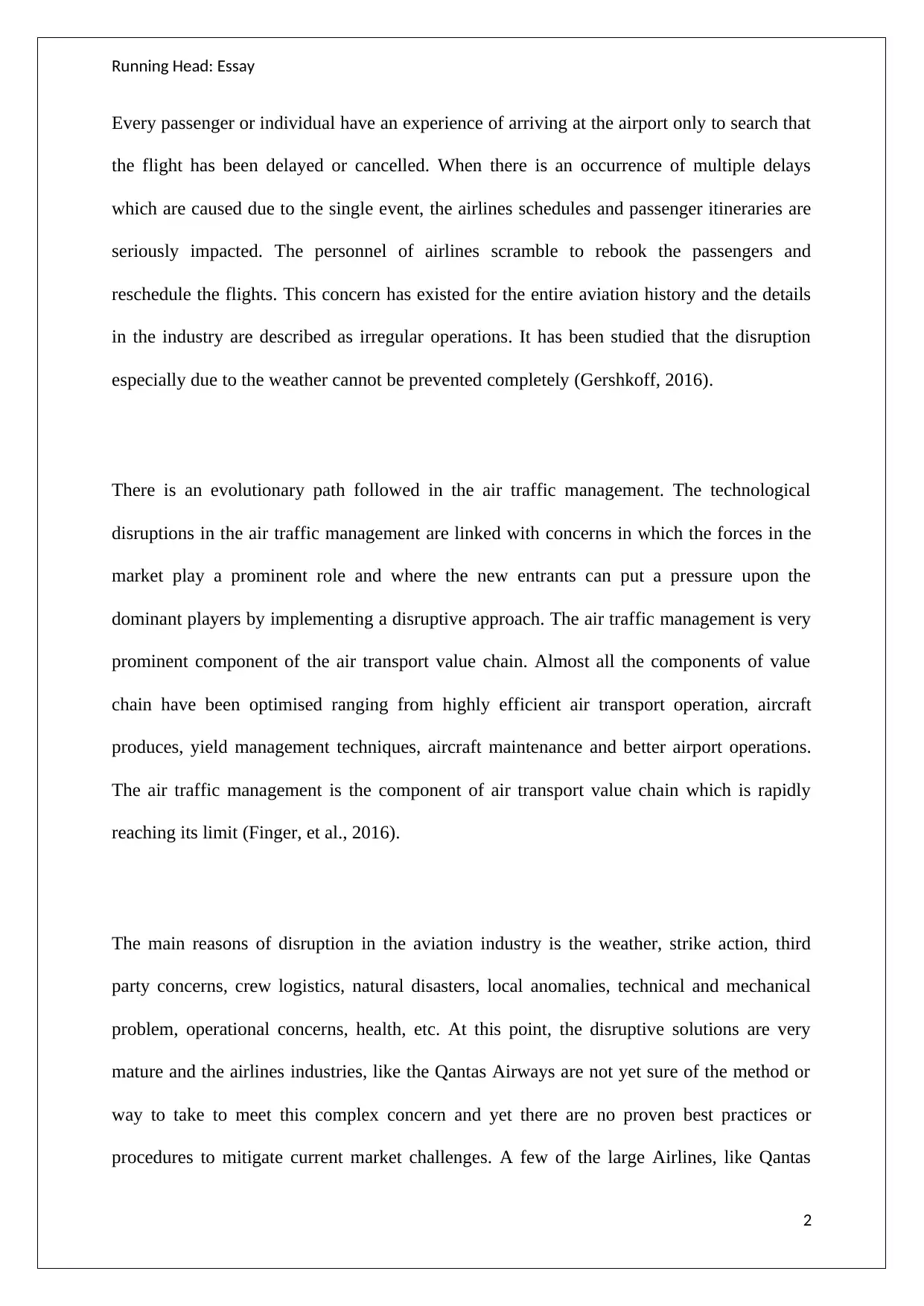
Running Head: Essay
Every passenger or individual have an experience of arriving at the airport only to search that
the flight has been delayed or cancelled. When there is an occurrence of multiple delays
which are caused due to the single event, the airlines schedules and passenger itineraries are
seriously impacted. The personnel of airlines scramble to rebook the passengers and
reschedule the flights. This concern has existed for the entire aviation history and the details
in the industry are described as irregular operations. It has been studied that the disruption
especially due to the weather cannot be prevented completely (Gershkoff, 2016).
There is an evolutionary path followed in the air traffic management. The technological
disruptions in the air traffic management are linked with concerns in which the forces in the
market play a prominent role and where the new entrants can put a pressure upon the
dominant players by implementing a disruptive approach. The air traffic management is very
prominent component of the air transport value chain. Almost all the components of value
chain have been optimised ranging from highly efficient air transport operation, aircraft
produces, yield management techniques, aircraft maintenance and better airport operations.
The air traffic management is the component of air transport value chain which is rapidly
reaching its limit (Finger, et al., 2016).
The main reasons of disruption in the aviation industry is the weather, strike action, third
party concerns, crew logistics, natural disasters, local anomalies, technical and mechanical
problem, operational concerns, health, etc. At this point, the disruptive solutions are very
mature and the airlines industries, like the Qantas Airways are not yet sure of the method or
way to take to meet this complex concern and yet there are no proven best practices or
procedures to mitigate current market challenges. A few of the large Airlines, like Qantas
2
Every passenger or individual have an experience of arriving at the airport only to search that
the flight has been delayed or cancelled. When there is an occurrence of multiple delays
which are caused due to the single event, the airlines schedules and passenger itineraries are
seriously impacted. The personnel of airlines scramble to rebook the passengers and
reschedule the flights. This concern has existed for the entire aviation history and the details
in the industry are described as irregular operations. It has been studied that the disruption
especially due to the weather cannot be prevented completely (Gershkoff, 2016).
There is an evolutionary path followed in the air traffic management. The technological
disruptions in the air traffic management are linked with concerns in which the forces in the
market play a prominent role and where the new entrants can put a pressure upon the
dominant players by implementing a disruptive approach. The air traffic management is very
prominent component of the air transport value chain. Almost all the components of value
chain have been optimised ranging from highly efficient air transport operation, aircraft
produces, yield management techniques, aircraft maintenance and better airport operations.
The air traffic management is the component of air transport value chain which is rapidly
reaching its limit (Finger, et al., 2016).
The main reasons of disruption in the aviation industry is the weather, strike action, third
party concerns, crew logistics, natural disasters, local anomalies, technical and mechanical
problem, operational concerns, health, etc. At this point, the disruptive solutions are very
mature and the airlines industries, like the Qantas Airways are not yet sure of the method or
way to take to meet this complex concern and yet there are no proven best practices or
procedures to mitigate current market challenges. A few of the large Airlines, like Qantas
2
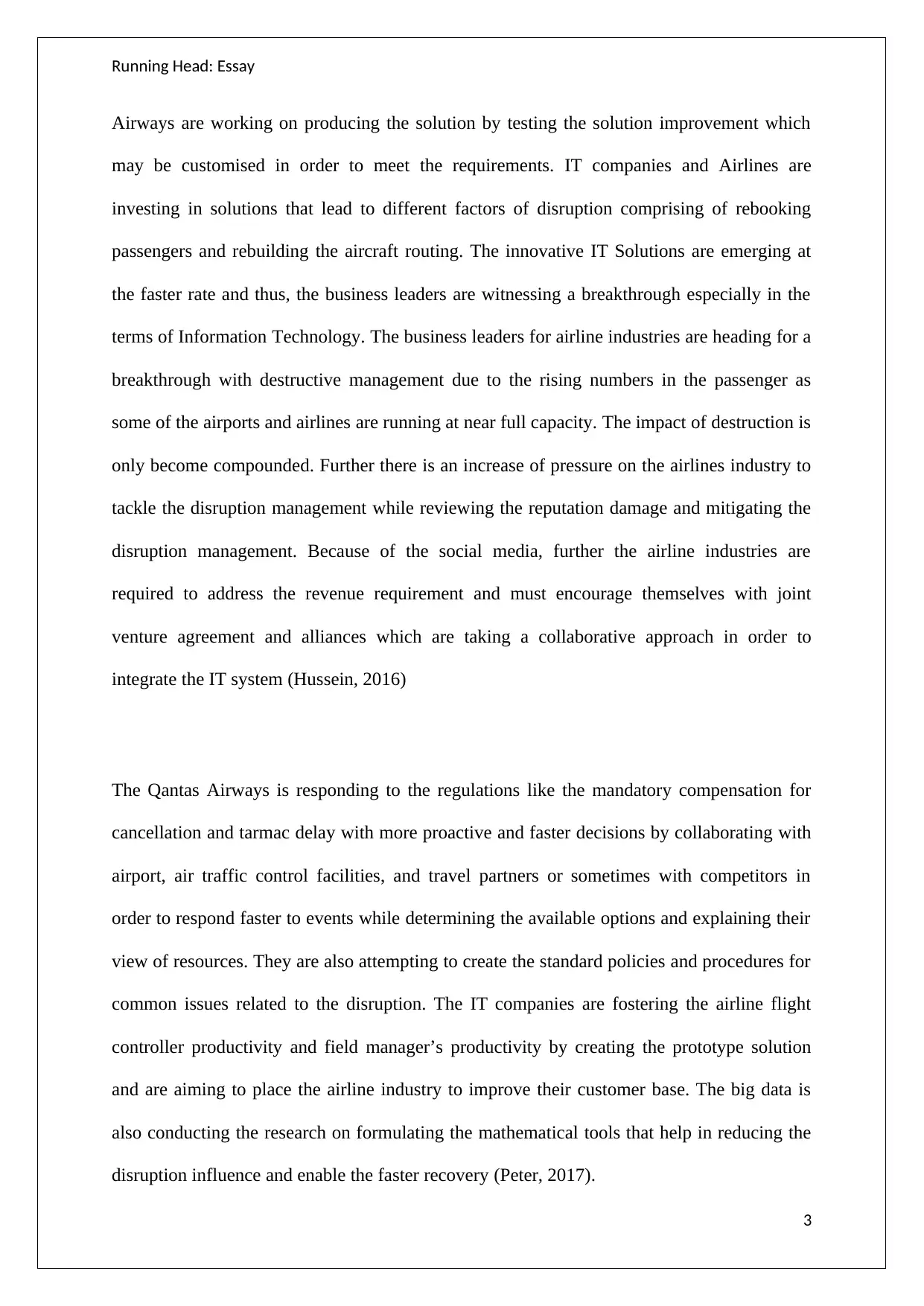
Running Head: Essay
Airways are working on producing the solution by testing the solution improvement which
may be customised in order to meet the requirements. IT companies and Airlines are
investing in solutions that lead to different factors of disruption comprising of rebooking
passengers and rebuilding the aircraft routing. The innovative IT Solutions are emerging at
the faster rate and thus, the business leaders are witnessing a breakthrough especially in the
terms of Information Technology. The business leaders for airline industries are heading for a
breakthrough with destructive management due to the rising numbers in the passenger as
some of the airports and airlines are running at near full capacity. The impact of destruction is
only become compounded. Further there is an increase of pressure on the airlines industry to
tackle the disruption management while reviewing the reputation damage and mitigating the
disruption management. Because of the social media, further the airline industries are
required to address the revenue requirement and must encourage themselves with joint
venture agreement and alliances which are taking a collaborative approach in order to
integrate the IT system (Hussein, 2016)
The Qantas Airways is responding to the regulations like the mandatory compensation for
cancellation and tarmac delay with more proactive and faster decisions by collaborating with
airport, air traffic control facilities, and travel partners or sometimes with competitors in
order to respond faster to events while determining the available options and explaining their
view of resources. They are also attempting to create the standard policies and procedures for
common issues related to the disruption. The IT companies are fostering the airline flight
controller productivity and field manager’s productivity by creating the prototype solution
and are aiming to place the airline industry to improve their customer base. The big data is
also conducting the research on formulating the mathematical tools that help in reducing the
disruption influence and enable the faster recovery (Peter, 2017).
3
Airways are working on producing the solution by testing the solution improvement which
may be customised in order to meet the requirements. IT companies and Airlines are
investing in solutions that lead to different factors of disruption comprising of rebooking
passengers and rebuilding the aircraft routing. The innovative IT Solutions are emerging at
the faster rate and thus, the business leaders are witnessing a breakthrough especially in the
terms of Information Technology. The business leaders for airline industries are heading for a
breakthrough with destructive management due to the rising numbers in the passenger as
some of the airports and airlines are running at near full capacity. The impact of destruction is
only become compounded. Further there is an increase of pressure on the airlines industry to
tackle the disruption management while reviewing the reputation damage and mitigating the
disruption management. Because of the social media, further the airline industries are
required to address the revenue requirement and must encourage themselves with joint
venture agreement and alliances which are taking a collaborative approach in order to
integrate the IT system (Hussein, 2016)
The Qantas Airways is responding to the regulations like the mandatory compensation for
cancellation and tarmac delay with more proactive and faster decisions by collaborating with
airport, air traffic control facilities, and travel partners or sometimes with competitors in
order to respond faster to events while determining the available options and explaining their
view of resources. They are also attempting to create the standard policies and procedures for
common issues related to the disruption. The IT companies are fostering the airline flight
controller productivity and field manager’s productivity by creating the prototype solution
and are aiming to place the airline industry to improve their customer base. The big data is
also conducting the research on formulating the mathematical tools that help in reducing the
disruption influence and enable the faster recovery (Peter, 2017).
3
Secure Best Marks with AI Grader
Need help grading? Try our AI Grader for instant feedback on your assignments.
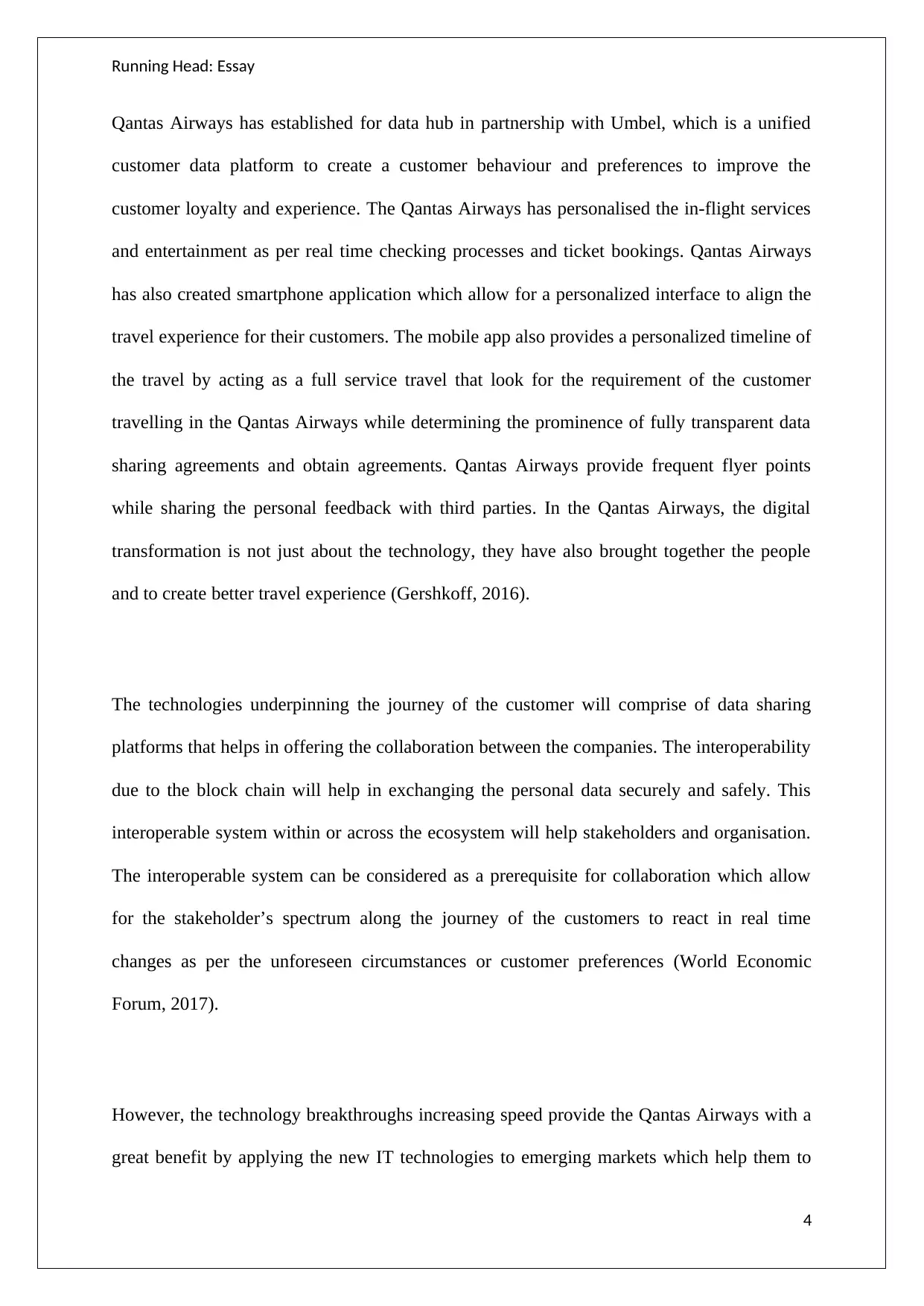
Running Head: Essay
Qantas Airways has established for data hub in partnership with Umbel, which is a unified
customer data platform to create a customer behaviour and preferences to improve the
customer loyalty and experience. The Qantas Airways has personalised the in-flight services
and entertainment as per real time checking processes and ticket bookings. Qantas Airways
has also created smartphone application which allow for a personalized interface to align the
travel experience for their customers. The mobile app also provides a personalized timeline of
the travel by acting as a full service travel that look for the requirement of the customer
travelling in the Qantas Airways while determining the prominence of fully transparent data
sharing agreements and obtain agreements. Qantas Airways provide frequent flyer points
while sharing the personal feedback with third parties. In the Qantas Airways, the digital
transformation is not just about the technology, they have also brought together the people
and to create better travel experience (Gershkoff, 2016).
The technologies underpinning the journey of the customer will comprise of data sharing
platforms that helps in offering the collaboration between the companies. The interoperability
due to the block chain will help in exchanging the personal data securely and safely. This
interoperable system within or across the ecosystem will help stakeholders and organisation.
The interoperable system can be considered as a prerequisite for collaboration which allow
for the stakeholder’s spectrum along the journey of the customers to react in real time
changes as per the unforeseen circumstances or customer preferences (World Economic
Forum, 2017).
However, the technology breakthroughs increasing speed provide the Qantas Airways with a
great benefit by applying the new IT technologies to emerging markets which help them to
4
Qantas Airways has established for data hub in partnership with Umbel, which is a unified
customer data platform to create a customer behaviour and preferences to improve the
customer loyalty and experience. The Qantas Airways has personalised the in-flight services
and entertainment as per real time checking processes and ticket bookings. Qantas Airways
has also created smartphone application which allow for a personalized interface to align the
travel experience for their customers. The mobile app also provides a personalized timeline of
the travel by acting as a full service travel that look for the requirement of the customer
travelling in the Qantas Airways while determining the prominence of fully transparent data
sharing agreements and obtain agreements. Qantas Airways provide frequent flyer points
while sharing the personal feedback with third parties. In the Qantas Airways, the digital
transformation is not just about the technology, they have also brought together the people
and to create better travel experience (Gershkoff, 2016).
The technologies underpinning the journey of the customer will comprise of data sharing
platforms that helps in offering the collaboration between the companies. The interoperability
due to the block chain will help in exchanging the personal data securely and safely. This
interoperable system within or across the ecosystem will help stakeholders and organisation.
The interoperable system can be considered as a prerequisite for collaboration which allow
for the stakeholder’s spectrum along the journey of the customers to react in real time
changes as per the unforeseen circumstances or customer preferences (World Economic
Forum, 2017).
However, the technology breakthroughs increasing speed provide the Qantas Airways with a
great benefit by applying the new IT technologies to emerging markets which help them to
4
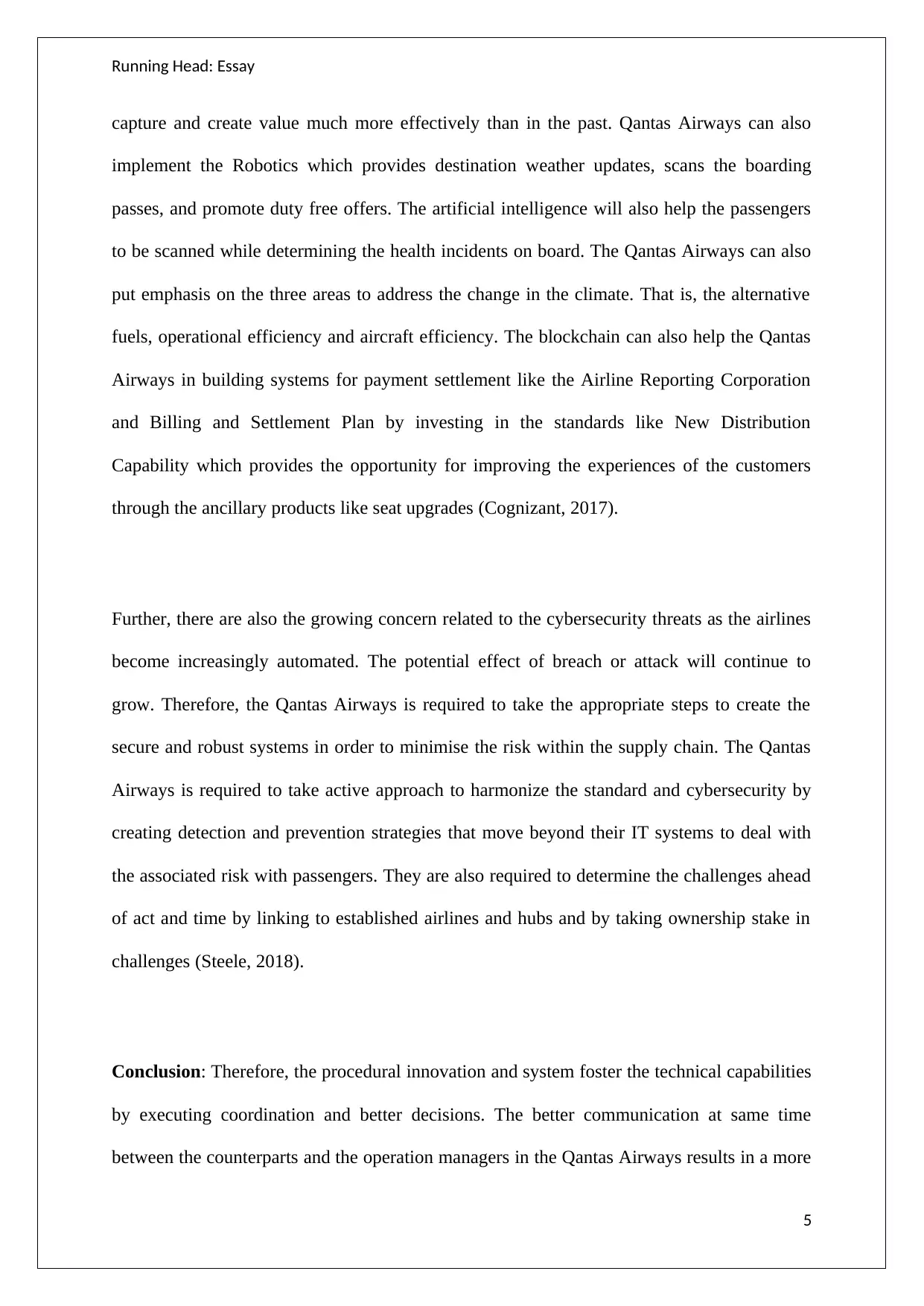
Running Head: Essay
capture and create value much more effectively than in the past. Qantas Airways can also
implement the Robotics which provides destination weather updates, scans the boarding
passes, and promote duty free offers. The artificial intelligence will also help the passengers
to be scanned while determining the health incidents on board. The Qantas Airways can also
put emphasis on the three areas to address the change in the climate. That is, the alternative
fuels, operational efficiency and aircraft efficiency. The blockchain can also help the Qantas
Airways in building systems for payment settlement like the Airline Reporting Corporation
and Billing and Settlement Plan by investing in the standards like New Distribution
Capability which provides the opportunity for improving the experiences of the customers
through the ancillary products like seat upgrades (Cognizant, 2017).
Further, there are also the growing concern related to the cybersecurity threats as the airlines
become increasingly automated. The potential effect of breach or attack will continue to
grow. Therefore, the Qantas Airways is required to take the appropriate steps to create the
secure and robust systems in order to minimise the risk within the supply chain. The Qantas
Airways is required to take active approach to harmonize the standard and cybersecurity by
creating detection and prevention strategies that move beyond their IT systems to deal with
the associated risk with passengers. They are also required to determine the challenges ahead
of act and time by linking to established airlines and hubs and by taking ownership stake in
challenges (Steele, 2018).
Conclusion: Therefore, the procedural innovation and system foster the technical capabilities
by executing coordination and better decisions. The better communication at same time
between the counterparts and the operation managers in the Qantas Airways results in a more
5
capture and create value much more effectively than in the past. Qantas Airways can also
implement the Robotics which provides destination weather updates, scans the boarding
passes, and promote duty free offers. The artificial intelligence will also help the passengers
to be scanned while determining the health incidents on board. The Qantas Airways can also
put emphasis on the three areas to address the change in the climate. That is, the alternative
fuels, operational efficiency and aircraft efficiency. The blockchain can also help the Qantas
Airways in building systems for payment settlement like the Airline Reporting Corporation
and Billing and Settlement Plan by investing in the standards like New Distribution
Capability which provides the opportunity for improving the experiences of the customers
through the ancillary products like seat upgrades (Cognizant, 2017).
Further, there are also the growing concern related to the cybersecurity threats as the airlines
become increasingly automated. The potential effect of breach or attack will continue to
grow. Therefore, the Qantas Airways is required to take the appropriate steps to create the
secure and robust systems in order to minimise the risk within the supply chain. The Qantas
Airways is required to take active approach to harmonize the standard and cybersecurity by
creating detection and prevention strategies that move beyond their IT systems to deal with
the associated risk with passengers. They are also required to determine the challenges ahead
of act and time by linking to established airlines and hubs and by taking ownership stake in
challenges (Steele, 2018).
Conclusion: Therefore, the procedural innovation and system foster the technical capabilities
by executing coordination and better decisions. The better communication at same time
between the counterparts and the operation managers in the Qantas Airways results in a more
5
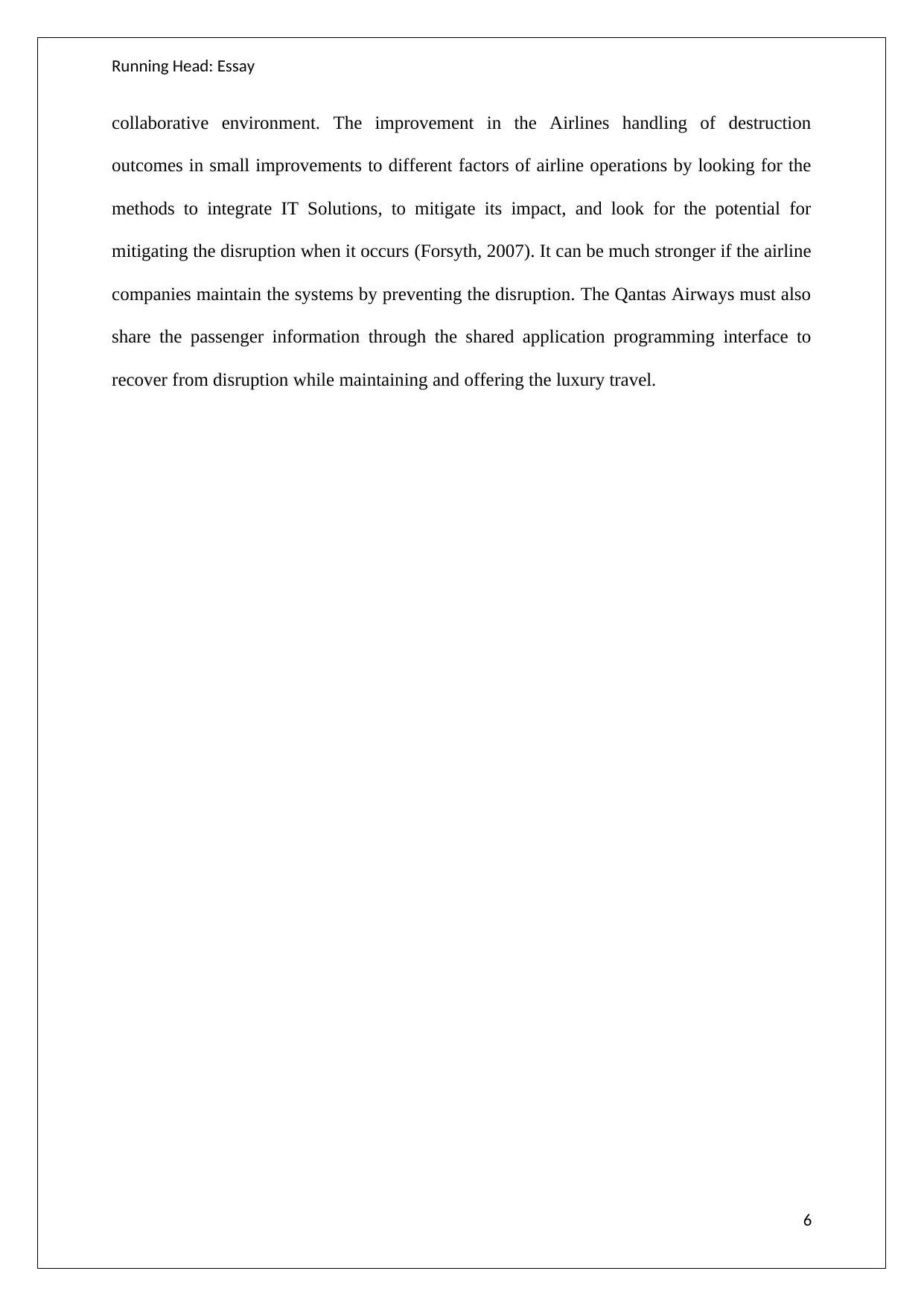
Running Head: Essay
collaborative environment. The improvement in the Airlines handling of destruction
outcomes in small improvements to different factors of airline operations by looking for the
methods to integrate IT Solutions, to mitigate its impact, and look for the potential for
mitigating the disruption when it occurs (Forsyth, 2007). It can be much stronger if the airline
companies maintain the systems by preventing the disruption. The Qantas Airways must also
share the passenger information through the shared application programming interface to
recover from disruption while maintaining and offering the luxury travel.
6
collaborative environment. The improvement in the Airlines handling of destruction
outcomes in small improvements to different factors of airline operations by looking for the
methods to integrate IT Solutions, to mitigate its impact, and look for the potential for
mitigating the disruption when it occurs (Forsyth, 2007). It can be much stronger if the airline
companies maintain the systems by preventing the disruption. The Qantas Airways must also
share the passenger information through the shared application programming interface to
recover from disruption while maintaining and offering the luxury travel.
6
Paraphrase This Document
Need a fresh take? Get an instant paraphrase of this document with our AI Paraphraser
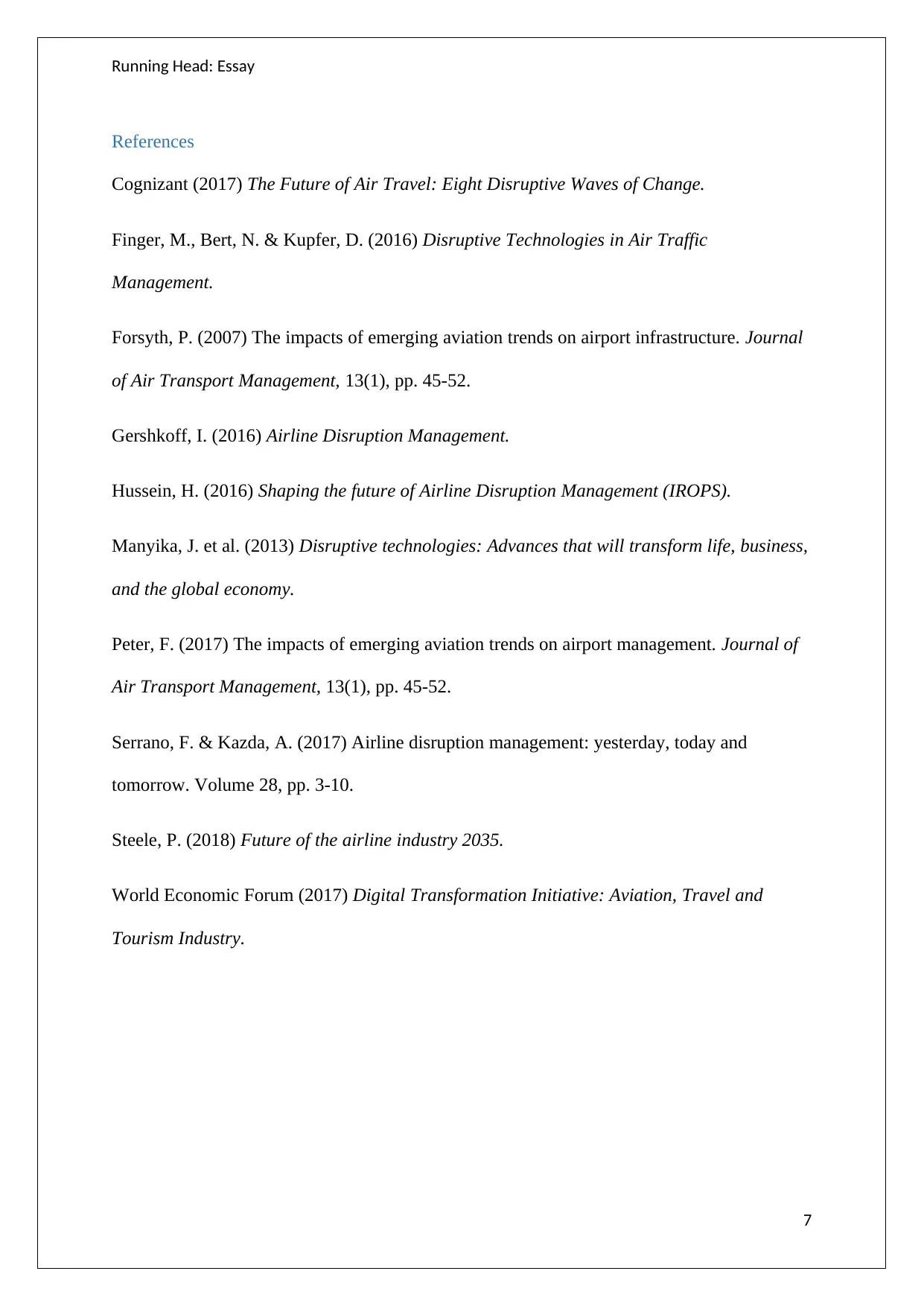
Running Head: Essay
References
Cognizant (2017) The Future of Air Travel: Eight Disruptive Waves of Change.
Finger, M., Bert, N. & Kupfer, D. (2016) Disruptive Technologies in Air Traffic
Management.
Forsyth, P. (2007) The impacts of emerging aviation trends on airport infrastructure. Journal
of Air Transport Management, 13(1), pp. 45-52.
Gershkoff, I. (2016) Airline Disruption Management.
Hussein, H. (2016) Shaping the future of Airline Disruption Management (IROPS).
Manyika, J. et al. (2013) Disruptive technologies: Advances that will transform life, business,
and the global economy.
Peter, F. (2017) The impacts of emerging aviation trends on airport management. Journal of
Air Transport Management, 13(1), pp. 45-52.
Serrano, F. & Kazda, A. (2017) Airline disruption management: yesterday, today and
tomorrow. Volume 28, pp. 3-10.
Steele, P. (2018) Future of the airline industry 2035.
World Economic Forum (2017) Digital Transformation Initiative: Aviation, Travel and
Tourism Industry.
7
References
Cognizant (2017) The Future of Air Travel: Eight Disruptive Waves of Change.
Finger, M., Bert, N. & Kupfer, D. (2016) Disruptive Technologies in Air Traffic
Management.
Forsyth, P. (2007) The impacts of emerging aviation trends on airport infrastructure. Journal
of Air Transport Management, 13(1), pp. 45-52.
Gershkoff, I. (2016) Airline Disruption Management.
Hussein, H. (2016) Shaping the future of Airline Disruption Management (IROPS).
Manyika, J. et al. (2013) Disruptive technologies: Advances that will transform life, business,
and the global economy.
Peter, F. (2017) The impacts of emerging aviation trends on airport management. Journal of
Air Transport Management, 13(1), pp. 45-52.
Serrano, F. & Kazda, A. (2017) Airline disruption management: yesterday, today and
tomorrow. Volume 28, pp. 3-10.
Steele, P. (2018) Future of the airline industry 2035.
World Economic Forum (2017) Digital Transformation Initiative: Aviation, Travel and
Tourism Industry.
7
1 out of 8
Your All-in-One AI-Powered Toolkit for Academic Success.
+13062052269
info@desklib.com
Available 24*7 on WhatsApp / Email
![[object Object]](/_next/static/media/star-bottom.7253800d.svg)
Unlock your academic potential
© 2024 | Zucol Services PVT LTD | All rights reserved.





